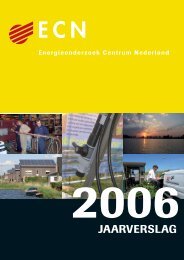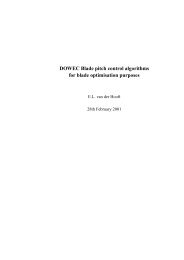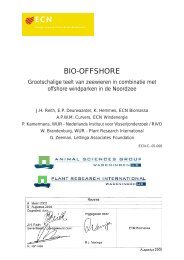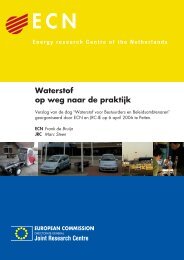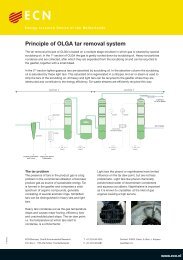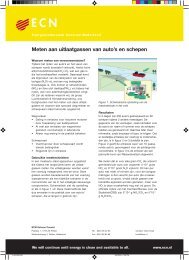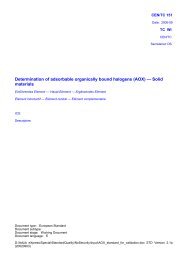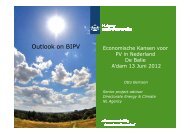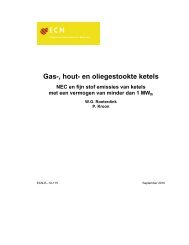PDF format (503 kB) - ECN
PDF format (503 kB) - ECN
PDF format (503 kB) - ECN
You also want an ePaper? Increase the reach of your titles
YUMPU automatically turns print PDFs into web optimized ePapers that Google loves.
The Impact of GHG Emission Reduction on the Western European Materials System<br />
D.J. Gielen<br />
<strong>ECN</strong>-Policy Studies, PO Box 1, 1755 ZG Petten, The Netherlands<br />
tel. +31-224-564460 E-mail: Gielen@ecn.nl<br />
Preliminary analysis for the MATTER workshop Factor 2/Factor 10, Utrecht, 2 April 1998<br />
Abstract<br />
This paper discusses preliminary results for the analysis of Western European GHG emission reduction in the<br />
materials system, based on MARKAL model calculations. The results show that the materials system contributes<br />
up to 50% to the total emission reduction at moderate emission reduction goals. Major changes due to<br />
GHG emission penalties occur in the materials production and in waste handling, while materials use is only<br />
significantly affected at penalty levels abov 100 ECU/t CO2.<br />
Introduction<br />
Greenhouse gas (GHG) emission reduction is a key issue for environmental policies in the first half of the 21st<br />
century. The countries of the European Union, the United States and Japan agreed at the UNFCCC conference<br />
in Kyoto in December 1997 to reduce their emissions by 8, 7, and 6% in the period 2008-2012, respectively,<br />
compared to their emissions for a reference year 1990 or 1995. Further emission reductions can be expected<br />
beyond this period.<br />
The Kyoto agreement covers six categories of greenhouse gases: carbon dioxide (CO2), methane (CH4), nitrous<br />
oxide (N2O), perfluorocarbons (PFCs), hydrofluorocarbons (HFCs) and sulphurhexafluoride (SF6). These emissions<br />
are aggregated on the basis of their global warming potential (GWP) for a time horizon of 100 years.<br />
A significant part of the GHG emissions can be attributed to the life cycle of materials. As a consequence, the<br />
production and the use of materials will be affected by GHG emission reduction policies. However, GHG emission<br />
reduction from a materials life cycle perspective has received little attention yet, and the impacts on the<br />
materials life cycle are still unclear. This paper discusses strategies to reduce emissions that are related to the<br />
life cycle of materials, and compares these strategies to other emission reduction strategies (see Figure 1). Special<br />
attention is paid to the interaction of emission reduction strategies. “Materials” includes all substances that<br />
are not produced for energy purposes. Food products are excluded from the category materials.<br />
MINING/<br />
CONVERSION<br />
ENERGY SYSTEM<br />
ENERGY<br />
PRODUCTION<br />
ENERGY<br />
PRODUCTION<br />
MATERIALS SYSTEM<br />
MATERIALS<br />
INDUSTRY<br />
MATERIALS<br />
PRODUCTION<br />
CONSUMER<br />
USE<br />
WASTE<br />
MANAGEMENT<br />
ENERGY<br />
RECOVERY<br />
Figure 1 Definition of the energy system and the materials system



